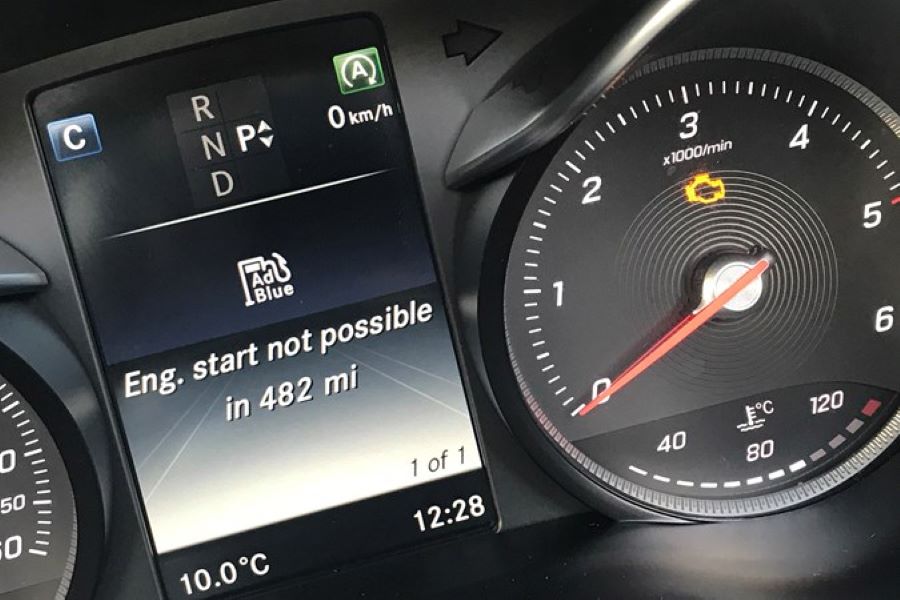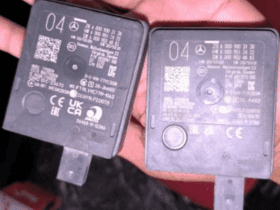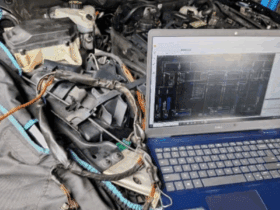Table of Contents
AdBlue Reset Mercedes: Causes, Codes & Complete Reset Procedure
When your Mercedes displays an AdBlue warning or the dreaded “Engine Start Not Possible” message, it usually means the Selective Catalytic Reduction (SCR) system needs attention.
This guide explains why AdBlue warnings appear, how to diagnose and fix the underlying issue, and the correct AdBlue reset procedure to restore your vehicle’s emission performance and compliance.
Why AdBlue Reset Is Important
The AdBlue system is a vital emission control feature in Mercedes-Benz diesel vehicles.
When fluid levels are low or the system detects a malfunction, a warning appears to protect the SCR catalyst and prevent excessive emissions.
If the problem persists, Mercedes vehicles initiate a countdown to “Engine Start Not Possible.”
Resetting the AdBlue system after repairs or refilling ensures that the ECU recognizes the correction and restores full functionality.
Common Triggers for an AdBlue Warning
| Cause | Typical Symptoms | How to Check / Fix |
|---|---|---|
| Low AdBlue level | Dashboard warning, countdown to no-start | Refill with certified AdBlue fluid |
| Crystallized dosing valve | Warning persists after refill | Visual inspection; clean or replace valve |
| Faulty AdBlue pump | Malfunction message, inconsistent pressure | Pressure test with XENTRY diagnostic |
| Sensor or wiring fault | False low level or no dose alerts | Inspect connectors, scan for codes |
| Software glitch | Warning remains after refill | Perform system reset or adaptation drive |
Mercedes AdBlue Fault Codes Explained
Code P13E400
Meaning: Malfunction in AdBlue dosing or NOx sensor circuit.
Common Causes:
- – Faulty NOx sensors or injectors
- – Low-quality AdBlue fluid
- – Software inconsistency in SCR module
Diagnosis & Fix:
- – Scan with XENTRY; check injector and NOx sensor values
- – Replace defective component
- – Perform software update and AdBlue reset
Code P13DF00
Meaning: SCR system unable to meet emission targets due to pressure or fluid quality fault.
Common Causes:
- – Leaks or cracks in AdBlue line
- – Low system pressure or pump failure
- – Contaminated or diluted AdBlue
Diagnosis & Fix:
- – Inspect for leaks and crystallization
- – Test pressure build-up and refill with certified fluid
- – Clear fault and confirm pressure within spec
Case Study: AdBlue Reset in Mercedes-Benz C300
Customer Complaint
The driver reported the warning “Engine Start Not Possible” on the instrument cluster of a Mercedes-Benz C-Class (C300).

Step 1: Diagnostic Scan
Action: Performed a full quick test using the Mercedes-Benz XENTRY diagnostic system.
Result: Detected multiple SCR-related codes (P13E400, P13DF00, 16D300–16CF00).
Note: Do not clear codes prematurely this erases vital diagnostic data.
Step 2: Identifying the Root Cause

Common root causes include:
- – Low-quality AdBlue
- – Faulty NOx sensors (pre- or post-catalyst)
- – Defective dosing valve or pump
- – Electrical contact issues or corrosion
Action: Addressed the origin fault (in this case, a malfunctioning dosing valve).
Step 3: Resetting the AdBlue System
Once the original fault was repaired, the reset procedure was performed using Mercedes XENTRY Diagnostic:
Reset Steps:
- 1. Run Guided Control in XENTRY.
- 2. Select “Reset Warning Message” under SCR system menu.
- 3. Wait for confirmation message “Successfully Performed.”
If the message “Reset Failed” appears, proceed with the Adaptation Drive.
Step 4: Adaptation Drive Procedure
Some models require an adaptation drive to clear the AdBlue countdown and verify proper system dosing.
Procedure:
- 1. Warm up engine: coolant ≥ 80 °C and catalyst ≥ 250 °C.
- 2. Drive 30 min between 80–120 km/h, alternating acceleration and deceleration.
- 3. Repeat 5 driving cycles if necessary.
- 4. Recheck DTCs and confirm that no warnings remain.
Result: AdBlue system reset successfully, no active codes, vehicle started normally.
Understanding Mercedes AdBlue Technology
AdBlue is a mixture of urea and demineralized water injected into the exhaust stream ahead of the SCR catalyst.
It reacts with nitrogen oxides (NOx), converting them into harmless nitrogen and water vapor.
In Mercedes vehicles, AdBlue is stored in a separate tank with its own sensors, heater, and dosing unit managed by the SCR control module.
Benefits of AdBlue:
- – Drastically reduces NOx emissions
- – Keeps engines compliant with Euro 6 standards
- – Enhances fuel efficiency and engine performance
DIY vs. Professional Tasks
| Task | DIY-Friendly | Dealer / Specialist |
|---|---|---|
| Refill AdBlue tank | Yes | – |
| Perform adaptation drive | Yes | – |
| Basic reset with OBD-II | If tool supports SCR | – |
| Full diagnostic scan & fault analysis | No | Required |
| Replace AdBlue pump, sensor, or valve | No | Dealer only |
When Do You Need to Perform an AdBlue Reset?
- – After refilling the AdBlue tank but the warning remains
- – After repairing SCR components (pump, injector, or NOx sensor)
- – When error codes like P13E400 or P13DF00 are stored and cleared
- – Following software updates or ECU adaptation procedures
Related Diagnostic Resource
If your Mercedes is showing electrical or emission system warnings, explore our complete diagnostic hubs:
Mercedes AdBlue Problems: Causes, Fixes & Reset Guide; discover step-by-step diagnostics for AdBlue system malfunctions, delivery pump issues, and reset procedures to restore emission compliance.
Mercedes Electrical Problems: Fix SAM, ECU & CAN Bus Faults; learn how to diagnose power loss, short circuits, and communication faults affecting your vehicle’s control modules.
Together, these resources provide a complete troubleshooting roadmap from control-unit power and CAN communication faults to AdBlue dosing and SCR system diagnostics.
Key Takeaways
- – Always fix the root cause before performing an AdBlue reset.
- – Never clear DTCs before identifying the origin fault code.
- – Use Mercedes XENTRY for accurate SCR diagnostics and resets.
- – If reset fails, perform an adaptation drive under controlled conditions.
Author Bio
Mercedes Expert is an automotive technical trainer and Mercedes-Benz diagnostics expert with extensive hands-on experience in XENTRY, DTS Monaco, and advanced system troubleshooting. He specializes in transforming real workshop case studies into structured learning content to help technicians, car owners, and enthusiasts understand complex vehicle systems.
Last update: November 2025






As I web website possessor I believe the content matter here is rattling great , appreciate it for your efforts. You need to keep it up forever! Great Luck.
Thank you! I really appreciate the encouragement.